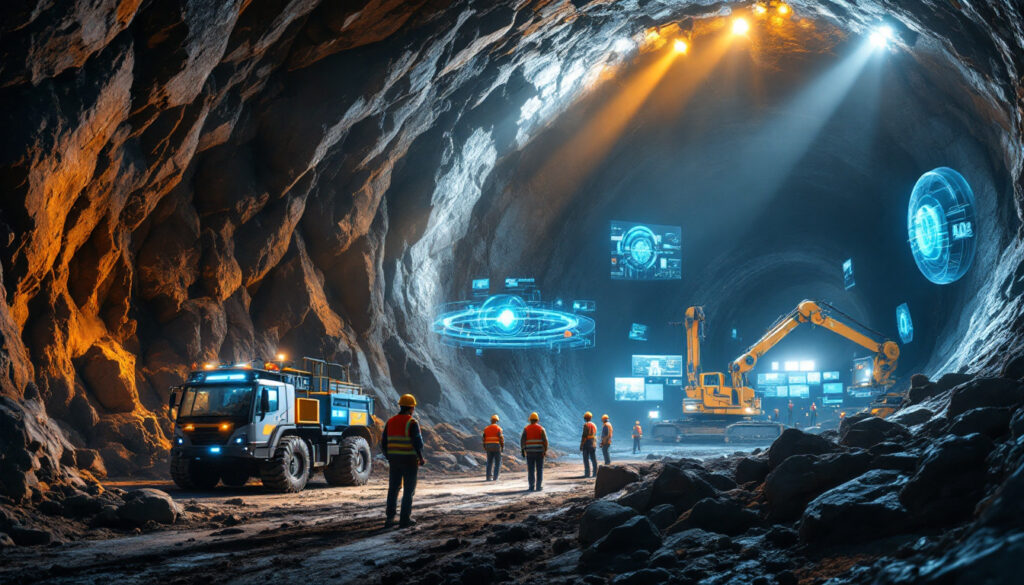What is Mine Planning and Why is it Important?
Mine planning stands as the cornerstone of any successful mining operation, serving as the strategic blueprint that guides every aspect of mineral extraction. At its core, mine planning is the systematic process of determining the safest and most efficient way to meet project goals while balancing technical requirements with community needs and environmental considerations.
The process integrates multiple data streams—geological surveys, marketing intelligence, production metrics, and geotechnical information—to create a comprehensive roadmap for extraction. The ultimate measure of success typically comes down to tons or pounds of metal produced, but modern mine planning in the Hermosa project extends far beyond simple production metrics.
Mine planning is inherently dynamic, requiring constant adaptation to changing conditions both underground and in the market. As new data becomes available, plans must evolve accordingly. This flexibility is critical in an industry where a single unexpected geological formation can necessitate complete redesigns of extraction methods.
Today's mine planning represents a delicate balance between maximizing resource recovery and minimizing environmental impact. The days of planning purely for extraction efficiency are long gone—contemporary mine plans must integrate community concerns, environmental safeguards, and sustainable practices from the very beginning.
How Does the Mine Planning Process Work?
The mine planning journey begins with exploration drilling and resource declaration, where geologists establish the fundamental understanding of what lies beneath the surface. This initial phase provides the baseline data upon which all subsequent planning will build.
As projects advance, they progress through increasingly detailed stages: concept studies outline broad possibilities, pre-feasibility studies narrow down options, and mining feasibility studies define the specific approach. Each stage involves exponentially more data collection and plan refinement, with feasibility studies requiring drilling density sufficient to declare reserves.
Modern software has revolutionized this process, allowing planners to test multiple scenarios in relatively short timeframes. Variables like pit boundaries, slope angles, cave footprints, stope sizes, cut-off grades, and production rates can be modeled and adjusted to optimize outcomes. What once took years of manual calculations can now be accomplished in weeks or months.
The iterative nature of mine planning cannot be overstated. As new information emerges—whether geological samples, market shifts, or community feedback—plans must be reconsidered and refined. In the Hermosa project, for example, the timeline shifted from initial concept studies in 2018 to comprehensive feasibility studies by 2023, with countless iterations in between.
What Are the Key Decision Factors in Modern Mine Planning?
Successful mine planning hinges on several interconnected decision factors that extend far beyond simply identifying where minerals exist. The primary consideration remains geological data—understanding the size, shape, and composition of the ore body forms the foundation of any mining operation.
Geotechnical aspects determine what kind of excavations are possible and safe. Engineers must evaluate rock mass characteristics, fault structures, and stress conditions to design stable excavations that won't compromise worker safety or resource recovery. At Hermosa, geotechnical considerations led to the selection of longhole open stoping with paste backfill, achieving an extraordinary 95% extraction rate while minimizing surface disruption.
Processing techniques represent another critical decision point. The methods used to recover metals from raw ore significantly impact both economic viability and environmental footprint. Modern planning considers not just recovery rates but also water usage, chemical requirements, and waste management.
Market considerations have become increasingly prominent in mine planning. Understanding who will buy the product, at what price, and under what conditions shapes everything from production targets to quality specifications. This market-oriented approach helps prevent the costly mistake of producing materials without established demand.
Perhaps most transformed in recent decades are community impact assessments and ESG challenges and global mining opportunities. The Hermosa project demonstrates this evolution dramatically—planners added over 100 miles to concentrate haul routes specifically to avoid driving through nearby communities, prioritizing community well-being over operational convenience.
How Does Technology Transform Mine Planning?
Technology has revolutionized mine planning, turning what was once an exercise in educated guesswork into a precision-driven science. Computer-aided design (CAD) modeling software now enables detailed three-dimensional visualization of mine designs, allowing planners to identify potential issues before ground is broken.
Specialized applications like stope optimizers automatically calculate the most efficient excavation dimensions based on ore grades, geotechnical parameters, and economic factors. Strategic optimization software sequences mining events to maximize net present value, ensuring the highest-grade ore is accessed at the optimal time.
Hydrogeological modeling has transformed water management, enabling accurate prediction of groundwater flow and dewatering requirements. This technology proves particularly valuable in sensitive watersheds, where Hermosa implemented rapid infiltration basins to maintain the original hydrological balance.
Automation technologies have reduced variables in drilling and blasting operations, yielding improvements in equipment utilization by approximately 30%. Autonomous vehicles operate with consistent parameters, eliminating the variations that come with human operation and enhancing both safety and efficiency.
Advanced sensing technologies have similarly transformed understanding mining drilling results. Drones provide high-resolution scans of underground environments, reducing overbreak and underbreak by 15-20%. These detailed surveys enable precise excavation, minimizing waste and optimizing resource recovery.
Perhaps most revolutionary is the development of digital transformation in mining—virtual representations of mines that enable real-time monitoring and adjustment. These sophisticated models, supported by WiFi/5G infrastructure, allow operators to visualize conditions that would otherwise remain invisible, from stress distributions to ventilation flows.
How Do Community and ESG Considerations Shape Mine Planning?
South32's Hermosa project exemplifies how community engagement and Environmental, Social, and Governance (ESG) principles have become foundational to modern mine planning. One of the most significant decisions involved changing from open pit to underground mining specifically to preserve the landscape of the Patagonia Mountains—a decision driven by community preference rather than purely economic factors.
The selection of longhole open stoping with paste backfill as the mining method was similarly influenced by ESG considerations. This approach minimizes surface footprint while maximizing resource recovery, demonstrating how technical and environmental goals can align rather than conflict.
Transportation planning reflects similar priorities. Hermosa's designers added approximately 100 miles to concentrate haul routes specifically to avoid driving through nearby towns. While this decision increased operational costs, it dramatically reduced impacts on local communities and demonstrated the operation's commitment to being a good neighbor.
Water management, often a contentious issue in mining operations, received particular attention in Hermosa's planning. The creation of rapid infiltration basins ensures that water remains within the original watershed, maintaining hydrological balance and addressing one of the most common community concerns about mining operations.
These examples highlight a fundamental shift in mine planning philosophy: early and frequent community engagement builds trust and improves project outcomes. More than 100 community meetings held since 2020 influenced Hermosa's design, with local input directly shaping technical decisions that might once have been made solely by engineers.
What Does the Future of Mine Planning Look Like?
The future of mine planning points toward increasing automation to improve both safety and efficiency. Remote operation centers will allow workers to control equipment from surface locations, removing personnel from hazardous underground environments while maintaining productivity. These systems are expected to reduce on-site labour requirements by approximately 40% while enhancing safety metrics.
Battery electric vehicles represent another transformative trend, reducing carbon footprints while simultaneously improving performance. At Hermosa and other forward-thinking operations, these vehicles enhance productivity by approximately 25% compared to diesel equivalents, while dramatically reducing emissions and ventilation requirements.
Advanced sensing technologies will continue to evolve, providing real-time data that enables immediate operational adjustments. Predictive analytics will anticipate changes in ore grades, ground conditions, and equipment performance before problems develop, shifting mining from a reactive to a proactive industry.
ESG considerations will become even more central to planning processes, integrated from the earliest conceptual stages rather than added as afterthoughts. Infrastructure will be designed from the beginning to support sustainability goals, avoiding costly retrofits and operational disruptions.
Continuous technological innovation will continue to challenge traditional approaches to mine planning. As artificial intelligence and machine learning capabilities mature, optimization algorithms will suggest novel solutions that human planners might never conceive, potentially revolutionizing modern extraction methods.
Industry analysts project that by 2030, approximately 50% of new mining operations will incorporate full automation infrastructure from initial construction, representing a fundamental shift in how mines are designed and operated.
How Does Hermosa Demonstrate Next-Generation Mine Planning?
The Hermosa project serves as a case study in forward-thinking mine planning, incorporating innovations that balance economic extraction with environmental and social responsibilities. One of the most significant decisions involved shifting from a decline access (the previous owner's plan) to shaft access, reducing the time to first ore by approximately 18 months while improving ventilation efficiency.
Innovation extended to the construction process itself. The main shaft was designed to stop during sinking to mine its own ore pass—an unconventional approach that saved an estimated $12 million in development costs while accelerating the timeline. This kind of creative problem-solving exemplifies the "art" aspect of modern mine planning.
Infrastructure for automation and digital systems was incorporated from the beginning rather than retrofitted later. Underground WiFi networks, fiber optic communications, and power systems were all designed to support future technological advances, creating a foundation for increasingly sophisticated operations throughout the mine's life.
Community input directly shaped design decisions, from transportation routes to water management systems. The planning team recognized that social license to operate represents as much of a critical path as technical milestones—without community support, even the most technically sound mine plan remains vulnerable.
Hermosa's approach to time metrics also demonstrates evolved thinking. Rather than focusing solely on total project timeline, planners prioritized time to first ore as a critical project metric, recognizing that earlier revenue generation dramatically improves project economics and stakeholder returns.
Perhaps most notably, Hermosa's planning integrates ESG principles into infrastructure decisions from day one, avoiding the costly pattern of retrofitting environmental protections into existing operations. This approach acknowledges that environmental and social performance represents not just compliance requirements but fundamental business value.
FAQ: Common Questions About Mine Planning
How many different scenarios do mine planners typically model?
Modern mine planning typically evaluates dozens of scenarios during the conceptual stage, narrowing to 3-5 detailed options during feasibility studies. Some scenarios are preserved for future reference, while others are discarded based on technical, economic, or stakeholder considerations. The process resembles branches of a decision tree, with each choice opening or closing future possibilities.
What tools do modern mine planners use?
Contemporary mine planners employ a sophisticated technological toolkit, including CAD modeling software, stope optimizers, strategic sequencing tools, hydrogeological modeling systems, and increasingly, digital twins. These applications integrate data from drilling programs, geotechnical investigations, market studies, and environmental surveys to create comprehensive mine designs that balance multiple objectives.
How has mine planning changed in recent decades?
Mine planning has evolved from a purely technical exercise focused on extraction efficiency to a holistic process incorporating community concerns, environmental impacts, and advanced technologies. Fifty years ago, plans might have considered only ore grades and mining methods; today's plans integrate everything from carbon footprints to community relationships, watershed preservation to wildlife corridors.
What makes mine planning both an art and a science?
The science of mine planning involves the technical aspects of extraction—calculating stope dimensions, determining slope angles, modeling ventilation systems. The art lies in balancing stakeholder needs, thinking creatively about solutions to complex problems, and envisioning possibilities that software alone might never suggest. The most successful mine planners combine rigorous analytical skills with creative thinking and stakeholder empathy.
How does water management factor into mine planning?
Water represents one of the most critical considerations in modern mine planning in the Hermosa project. Operations must model aquifer reactions to pumping, design systems to manage both shortage and excess, and create infrastructure that maintains watershed integrity. At Hermosa, rapid infiltration basins ensure that water remains within the original watershed, addressing one of the most common concerns about mining operations.
Ready for Early Access to the Next Major Mineral Discovery?
Stay ahead of the market with real-time alerts on significant ASX mineral discoveries, powered by Discovery Alert's proprietary Discovery IQ model that turns complex mineral data into actionable insights. Visit our discoveries page to understand why historic mineral discoveries can generate substantial returns for savvy investors.




